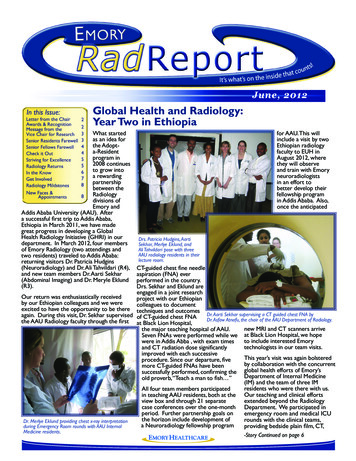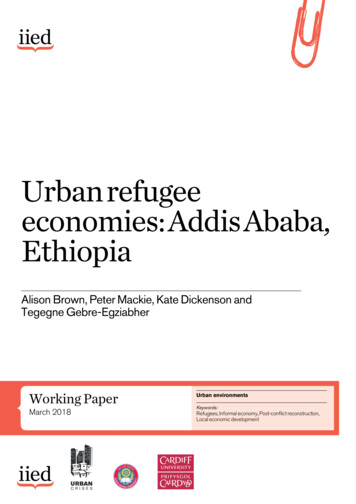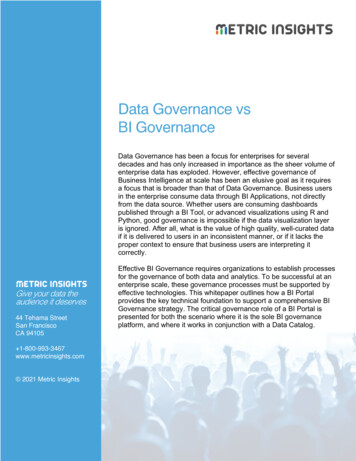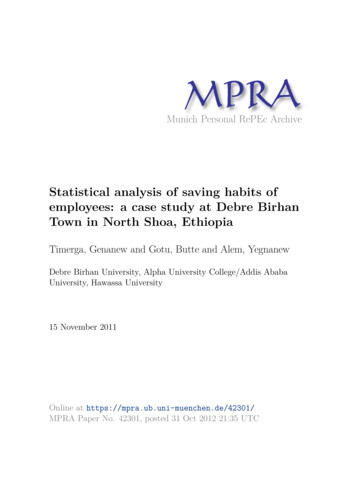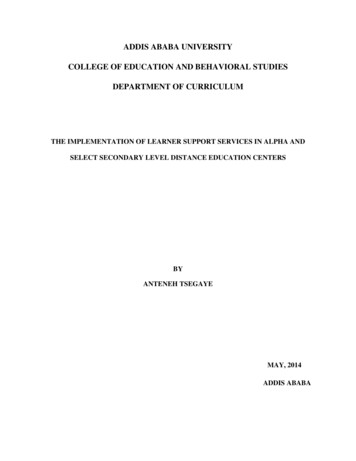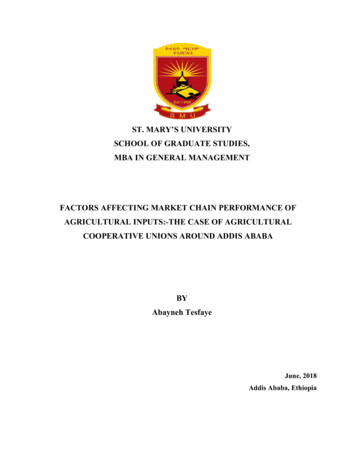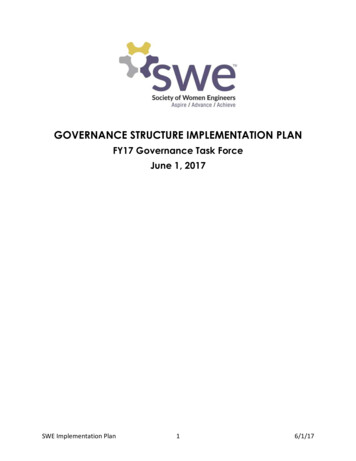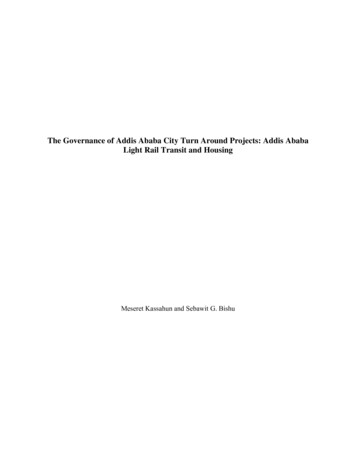
Transcription
The Governance of Addis Ababa City Turn Around Projects: Addis AbabaLight Rail Transit and HousingMeseret Kassahun and Sebawit G. Bishu
Table of ContentTable of Content .iiList of Tables and Figures . iiiAbstract .iiiI. Introduction . 11.1. Objectives of the study . 21.2. Conceptual and analytical framework, research questions, and methodology . 21.2.1. Governance, urban governance, and Ethiopia’s urban governance context . 31.2.2. Urban governance: Context matters . 51.2.3. A political economy analytical approach . 61.2.4. The political Economy of urban governance in Ethiopia . 71.2.5. Ethiopia’s ‘developmental state’ and revolutionary democratic governanceapproach . 81.2.6. Urban governance as analytical framework . 111.2.7. Research questions . 131.2.8. Methodology. 14II. Addis Ababa City: History, urbanization trends, and socio‐economic profile . 172.1. Addis Ababa City: Its Origin . 172.2. Urbanization trends and population dynamics. 172.3. Addis Ababa City Governance systems and structures . 192.4. Addis Ababa Economic profile. 202.4.1. Urban finance. 202.4.2. Unemployment . 222.4.3. Addressing Gender Inequality . 22III. Flagship Projects: Addis Ababa Light Rail Transit and housing. 223.1. Flagship project I: Addis Ababa Light Rail Transit . 223.1.1. Overview of Public Transportation in Addis Ababa . 233.1.2. Light Rail Transit: Its origin, discursive rational and the politics around financingthe project . 233.1.3. AA‐LRT Governance Structure, Institutional and Human Resource Capacity . 293.1.4. AA‐LRT Service Effectiveness . 323.1.5. Integration of LRT with Other City Transport Systems . 363.1.6. Inclusiveness of Gender and Other Socio‐economic groups in AA‐LRT . 373.1.7. Economic viability of LRT . 393.1.8. Discussion and analysis . 393.2. Flagship Project II: Integrated Housing and Development Project (IHDP) . 423.2.1. Over View of Housing Delivery in Addis Ababa . 423.2.2. Forces Shaping Housing Market in Addis Ababa . 433.2.3. Key Actors in the Housing Sector . 463.2.4. Public Housing Program: The Integrated Housing Development Program (IHDP). 493.2.5. Program Scope, Institutional Structure and Process . 49Project Phases . 523.2.6. Target Population . 55ii
3.2.7. Delivery Process . 553.2.8. Housing Typology, Loan Groups and Land Use. 563.2.9. Financing the IHDP program . 57Financing Condominium Units (Individual Mortgage Loans). 583.2.10. Government Subsidy. 583.2.11. Cost . 593.2.12. Affordability and Savings . 593.2.13. Program Impact and Path Dependency Effect . 613.2.14. The governance of the IHDP program . 713.2.14. Policy and Program Processes . 74IV. Conclusion and Implications . 814.1. Conclusions . 824.2. Implication to policy and future research . 874.2.1. Implications to policy . 874.2.2. Implications to research . 884.3. Limitations of the study . 88References . 89List of Tables and FiguresI. List of TablesPageTable 1: Urban governance analytical categoriesTable 2. Number of key informants and direct beneficiaries of thetwo flagship projects13Table 3. National Urban and Rural Population Size trend 1984-2014Table 4: Population Size and growth rate: 1984, 1994, 2007, 2012.Table 5. Addis Ababa City Administration Revenue performance from2010 – 2015 in Billions (Et Birr)Table 6. Addis Ababa City Administration development focusedexpenditure in billions (Et Birr)Table 7: Typologies in Addis AbabaTable 8: Housing units delivered Phase I of the IHDP projectTable 9. Growth in the number of contractors and construction managersTable 10: Number of housing created at the second phase of the projectTable 11: Total number of employment created during phase one and twoTable 12: Interest rate for condominium housing unit mortgageTable 13: Condominium housing price revision and price percentage increaseTable 14: Summary of program action and unintended program impactTable 15. Summary of LRT and Housing governance process usingthe governance analytical categories1718iii142021455152525355576882
List of FiguresFigure 1. The city of Addis Ababa’s public expenditure on road and housingdevelopment from 2010 – 2015 in billion ETBFigure 2: Organization of Addis Ababa City AdministrationFigure 3. AA-LRTFigure 4. LRT line induced traffic jam around roundaboutsFigure 5. LRT induced traffic jam near one LRT StationFigure 6: AA-LRT StructureFigure 7: AA-LRT RoutesFigure 8: One AA-LRT stationFigure 9: New BRT plan to integrate the LRTFigure 10: IHDP institutional frameworkFigure 11: Payment to income ratio of the IHDP program as a functionof percentile of household consumption, Addis Ababa.Figure 12 Lideta inner city renewal site 2008 (above) and 2014 below (left)Figure 13 Jemo urban periphery development site 2005 (above) and 2009(below) (right):Figure 14: Displaced Kebele housing residentiv220212627293333365058626264
v
AbstractThe purpose of this study is to describe and analyze urban governance processes using the AddisAbaba Light Rail Transit (AA-LRT), and the Integrated Housing Development Program (IHDP),as flagship projects that have turned the City of Addis Ababa around. The study utilized apolitical economy analysis and used PASGR’s urban governance analytical categories as guidingframeworks. Qualitative in-depth interviews with key informants and focus group discussionswith Light Rail Transit users were used as major sources of empirical data. In addition,secondary data sources, relevant literature and official documents were reviewed and used tocomplement the findings. Findings from this study highlight the genesis and discursive rationalof the flagship projects, the politics behind financing both projects, as well the governancestructure, process, and systems of LRT and housing. Major findings show that Ethiopia’s keyurban policy and strategic documents reflects the basic democratic governance characteristicswhere diverse actors are expected to take significant roles in the production and delivery ofquality-adequate urban services for city dwellers. Findings show that the flagship projects arehighly integrated within Ethiopia’s economic growth and social transformation. Consequently,the projects are instrumental in employment creation, which in turn contributes to the overallurban poverty reduction efforts. The fact that the two flagship projects evolved in differentphases of the country’s socio-economic development trajectories, the study found variationbetween the LRT and Housing projects on key urban governance dimensions. Particularly,differences were visible in governance and power, institution and capacity building, as well asgender dimensions of urban governance analytical categories. In this regard, non-state actors hada crucial role in the initiation of the housing project. Moreover, the housing project has allowedth e participation of the private sector under the guidance of the state; whereas, the LRT projectwas purely Initiated and implemented by the federal government, leaving no room for the voiceof non-state actors. In terms of the service delivery dimension of urban governance, findingsconfirm that the flagship projects significantly contributed in enhancing access to moderntransport and housing services for the low and middle-income segments of the residents of AddisAbaba. Moreover, the flagship projects have strong similarities on the urban symbolismdimensions of urban governance at national and international spheres. However, major findingsfrom the analysis on the governance of the flagship projects show contradictions between howurban governance is conceptualized in Ethiopia and the actual practice in the field. Based onmajor findings, the study concludes that Ethiopia needs to redefine its urban governanceapproach and strategies coherently with its political ideology called “developmental statedemocracy”. Furthermore, the conclusion considers implications for policy and practice in termsof making urban transport and housing services efficient and effective.Key words: Addis Ababa, Ethiopia, governance, housing, light rail transit, urban governanceiii
I.IntroductionThis study reports the findings of research on urban governance processes related to the AddisAbaba Light Rail Transit (AA-LRT) and the Integrated Housing Development Project (IHDP).These two Addis Ababa’s mega urban projects were selected as flagship projects since theyfulfill the criteria of “Turn Around Cities” outlined in PASGR’s research framework paper: There is a marked improvement in the economic performance of the city over the past 510 years, with prospects for sustained growth, defined narrowly in GDP terms; There is an expanding public investment agenda, with a clear focus on economicinfrastructure, especially investments that can enhance productivity and inclusivity, e.g.public transport, road and rail infrastructure, social development investments andhousing; There is evidence of fast-tracked projects over and above the routine operations of thecity, that enjoy dedicated resources, implementation mechanisms and high level politicalbacking, manifest in “world-class” and/or “turn-around” discourses; A policy and institutional commitment to effective urban governance and management isvisible in one form or another; and There is an expressed desire for international recognition and reputation building asbeing, for example, world-class and/or globally competitive (p. 4-5).Undoubtedly, the City of Addis Ababa meets these PASGR’s criteria of ‘turn around cities’.Firstly, the City has recorded steady economic growth as measured by GDP. The City has grownby an average 15% during the during Ethiopia’s first Growth and Transformation Plan (GTP-I)period, i.e. between 2010-2015 (Addis Ababa Bureau of Finance and Economic Development[AA-BoFED], 2016). Evidence from the State of Ethiopian Cities report shows that, the city’sGDP level accounts for 25% of the aggregate urban GDP and 9.9% of the national GDP (p.21)(Ministry of Urban Development and Housing Construction & Ethiopian Civil ServiceUniversity, 2015). The trend shows aFigure 1. The city of Addis Ababa’s publicsustained economic growth suggesting theexpenditure on road and housing development fromcity’s contribution to the country’s overall2010 – 2015 in billion ETBeconomic growth and poverty reductionendeavor. Secondly, Addis Ababa expanded25its investment on major development focused2020Totalexpenditure (i.e. social services and economic18expendituredevelopment such as health, education, water,1512.5road, housing, and micro and smallRoad108.3enterprises). According to Addis Ababa6.775.7 5.854.9Bureau of Finance and Economic3.9Housing1.5 0.78 1.18 1.111.4 0.381.22 0.52Development (2016) the city’s development0.260focused expenditure increased from ETB 2.9billion in 2010 to ETB 13.1 billion in 2015.Out of this total development focusedSource: Computed from data displayed on Addisexpenditure, road infrastructure developmentAbaba City Administration Growth andand housing construction are the two sectorsTransformation Plan II (p.11)that took the lion share of the cityadministration’s public expenditure (see figure 1).1
The AA-LRT and IHDP projects demonstrate Addis Ababa’s turn around process and boldlyillustrate Ethiopia’s urban development policy and program paradigm shift. The two flagshipprojects are showcases for the Ethiopian government to demonstrate its pro-poor, growthoriented policies. The projects furthermore demonstrate Ethiopia’s ‘developmental state’narrative aiming at ensuring the city’s competitiveness through state led planning andimplementation to close the existing public transportation and housing services gap with highlevel government’s political backing. Both projects demanded large-scale financial commitmentand they benefited from the Federal and the Addis Ababa City government’s commitmenttowards instituting separate governance and management systems in order to accelerate theirsuccessful implementation.The flagship projects are often cited as showcases of Ethiopia’s progress as one of the fastestgrowing and urbanizing economies in Africa. The two projects have received recognition inchanging the image of the country in both national and international arenas (see: TheEconomist’s and Bloomberg’s September 20151 report as well as Reuters’ report on Ethiopia’sambitious housing project2).1.1. Objectives of the studyAgainst this background, this study explains and analyzes the governance structure, process andsystems of the two flagship projects that turned around the City of Addis Ababa. Specifically, itexplores: The discursive rationale and strategy of AA-LRT and IHDP as the City of Addis Ababa’surban development agenda and priority programmes that are invested with politicalcapital; The extent to which the central and urban governments invested in the city’s flagshipinfrastructure projects that define the turnaround over the last 10 years compared to othersectors; The politics surrounding the projects’ investments; The relationship between the Federal and City government and the extent to which itinfluenced the projects; and The benefit of AA-LRT and IHDP to the different economic, political, social, gender andethnic groups in the city.1.2. Conceptual and analytical framework, research questions, and methodologyIn this section, the conceptualization of urban governance, the specific analytical framework thathelped organize the study findings, the research questions, as well as the underlyingmethodology are discussed. In conceptualizing urban governance in Ethiopia, we situate theconcept within Ethiopia’s political economy of development paradigm in general and rights-cities-idUSKCN12P1SL2
development discourse in particular. Therefore, this study elaborates Ethiopia’s developmenttrajectory, which is highly entrenched in the political ideology of the ruling party that embracedthe central role of the “developmental state” and the ruling party in directing socio-economicdevelopment1.2.1. Governance, urban governance, and Ethiopia’s urban governance contextSince the 1990’s scholars from various disciplines have made relentless efforts to conceptualizeand operationalize the term ‘governance’. However, the efforts yield little success in providing aclear and universally accepted definition (Aher, 2000). Obeng-Odoom (2012) also asserts thatdefining governance “remains” difficult (p. 204). Hendriks (2013) argues that the definition of‘governance’ and ‘containers’ are the same, where “governance contains a lot, and it is hard totell where it exactly begins and ends” (p.555). For Ahers (2000) the existence of a variety ofdefinitions for the term “governance” is associated with the issues and purposes that areconsidered in explaining governance. For instance, governance is seen as theory (see Stoker,1998; Perre, 2005) as an analytical framework, a normative model, and an empirical object ofstudy (Perre, 2005). Some scholars interpret governance as an end in itself, while others see it asan analytical framework or as a means to promote sustainable development (Kjaer, 1996, quotedin Ahers, 2000). Ahers (2000) tries to summarize the underlining conceptual considerations inexisting governance definitions. One conceptual approach views democratic government asunalterable condition; where the idea of good governance is promoted as corresponding todemocracy. The second approach in conceptualizing governance emphasizes institutionalcapacities of states, focusing on characteristics of the government machinery such as autonomy,rationality, efficiency and technocratic capability. Lastly, others conceptualize governancethrough amplifying the role of informal institutions (culture, habits, traditions) that shapeindividual behavior and subjective perceptions of the governance framework (pp.16-17).The fact that the concept of governance was originated and developed in Western countriesreflects the contextual reality of how governing mechanisms are structured and systematized.Hence, much of the explanation as well as the measurement of governance mostly promptedliberal and neo-liberal ideals with the assumption that the state-society relationship is structuredand arranged with active participation of various actors such as the different levels of State, theprivate sector and citizens’ associations. This conceptualization, however, may not be trueglobally. Recent developments in the governance discussion show that democratic participationand accountability may not be a necessary condition to define governance (Fukumaya, 2013). Inhis article titled “What is governance?” Fukumaya (2013) defines governance simply as “as agovernment’s ability to make and enforce rules, and to deliver services, regardless of whetherthat government is democratic or not (p.350). Fukumaya further argues that“ Government is an organization, which can do its functions better or worse;governance is thus about execution, or what has traditionally fallen within the domain ofpublic administration, as opposed to politics. An authoritarian regime can be wellgoverned, just as a democracy can be mal-administered (p. 351).According to Fukumaya, there is no adequate empirical evidence on whether or not democracyand governance are mutually supportive. Hence, governance is all about the performance of3
government. Fukumaya’s definition highlights the importance of looking at whether or notgovernments are capable of delivering services and reinforcing rules stipulated in their owncontexts.The concept of governance is also endorsed in explaining and evaluating the management ofurban affairs. As a result, urban governance as a necessity for an inclusive and sustainable, aswell as pro-growth urban development paradigm, has received significant attention on a globalscale (Harpham & Boateng, 1997; Melo & Baiocci, 2006; Obeng-Odoom, 2012; UNHABITAT, 2002). The absence of consensus and clarity on what constitutes governancesignificantly influenced how urban governance is defined. Hence, it is easy to discern theprotracted confusion in the description of what comprises urban governance. Much of thedefinitions available in the literature promptly describe urban governance as mechanisms thatcoordinate various actors to enhance an effective, all inclusive, and efficient socio-economicurban development. For instance, according to Harpham and Boateng (1997) urban governanceentails the process through which diverse actors take significant roles in the production anddelivery of quality-adequate urban services for city dwellers. This implies that urban governanceas a discourse within a given political-economic context offers a mechanism that enhancesdevolution of power as well as authority at different level of urban context for effective andefficient management of urban affairs. Similarly, Hendrick (2013) defines urban governance as“ more or less institutionalized working arrangements that shape productive and correctivecapacities in dealing with urban steering issues involving multiple governmental andnongovernmental actors” (p.555). Melo & Baiocchi (2006) define urban governance as ”theconfiguration of interactions between public and private actors with a view to achievingcollective (not private) goals in a particular territory” (p. 591). Lindell (2008) defines urbangovernance as “multiple sites where practices of governance are exercised and contested, avariety of actors, various layers of relations and a broad range of practices of governance thatmay involve various modes of power, as well as different scales” (p.1880).The definitions offered above refer to urban governance as a system of inclusive andparticipatory decision-making and implementation of urban policies, involving activeparticipation of diverse actors including citizens, private institutions, and organized interestgroups at different levels, as well as effective and sustainable socio-economic growth anddevelopment of a city. A more comprehensive definition on the nature and extent of urbangovernance is found in the UN-Habitat (2002) global “urban good governance campaign”document. Accordingly, urban governance is:“The sum of the many ways individuals and institutions, public and private, plan andmanage the common affairs of the city. It is a continuing process through whichconflicting or diverse interests may be accommodated and cooperative action can betaken. It includes formal institutions as well as informal arrangements and the socialcapital of citizens.” (p.14).UN-Habitat’s definition best describes the dynamic and complex relationship between citizens,public and private actors in urban agenda setting and decision-making processes. Besides, thedefinition acknowledges the importance of both formal and informal institutions in the overallprocess of governing urban affairs. The dynamic relationship between actors at all level in the4
execution of economic, political and administrative authority helps to create inclusive urbanspaces that nurture pluralistic processes (UN-HABITAT, 2002). UN-Habitat’s conceptualizationalso assumes the interaction of multiple actors using democratic participatory urban planning anddecision making through involving both formal and informal institutions and thereby ignorescontexts where government is the sole actor in guiding the planning and implementation of urbanpolicies.Despite the relevance of the above definitions in understanding urban governance, its processesand mechanisms through the involvement of relevant actors i.e. both governmental and nongovernmental and the use of organizing their actions and resources for the urban common good,it fails to express governance in contexts where there is little or no democratic accountability.Hence, the following section describes existing debates and the limited applicability of urbangovernance concepts in the African context. It also provides an explanation of the politicaleconomy of urban governance in the Ethiopian context as a background to analyze thegovernance of the two Addis Ababa city turn around flagship projects.1.2.2. Urban governance: Context mattersUrban governance encompasses processes and mechanisms through which significant actorsorganize their actions and resources for the urban common good through utilization of economic,social, and environmental resources is important. However, further explanation on which actorsactually participate in planning and implementation of urban policies is indispensable. Recentefforts in disentangling governance as a development paradigm consistently show its limitationin producing the intended results. This significantly challenges its universal applicability. Thismainly relates to the incompatibility of fundamental assumptions that urban governanceembraces in different context. Although the global campaign on “urban governance” enhancedthe commitment of many countries globally, there is no adequate evidence for its effectiveness inensuring sustainable urban development and growth. For instance, Correa and Correa (2013)argue that the notion of “good governance”’ is unnecessary for transformative pro-poor growth(p. 639). More importantly, the African Power and Politics Program (APPP) constantlydemonstrate that African countries do not need to adopt the Western good governance agendawholesale anymore. Based on a critical analysis of African countries historical, socio-economicand political organization and traditional governing mechanisms, APPP concluded that thedimensions of governance in the Western sense are absent, limiting the continent’s ability tobecome successful in obtaining the presumed good governance outcomes (Booth, 2011; Hyden,2008; Khan, 2014). More importantly, APPP demonstrates that Asian countries economicsuccess has shown little correlation with the proposed global campaign on good governance(Kelsall, 2008). Based on their findings, APPP researchers have been questioning theuniversality of the global good governance agenda in enhancing Africa’s economic growth anddevelopment (Kelsall and Booth, 2009). Hence, strong suggestions have been made towards“working with the grain”, a notion that embraces Africa’s local norms, structures, practice, andprocesses instead of trying to change it (Booth, 2009; 2011; Kelsall, 2008). Furthermore, theAPPP findings introduced “developmental patrimonialism/developmental (neo) patrimonialism”(see Kelsall & Booth et al., 2010; Booth & Golooba-Mutebi, 2011; Kelsall, 2011). According toBooth and Golooba-Mutebi (2011) developmental patrimonialism, raises difficult questionsabout “tradeoffs between liberal freedoms and human rights on the one hand and development5
outcomes and thus (other) human rights on the other (p. 4). Hence, conceptualizing urbangovernance needs to be situated within the historical, social, economic, and political trajectoriesthat constantly shape the governance structures and systems in any society.1.2.3. A political economy analytical approachThis study uses a political economy analysis within Ethiopia’s political ideology in elaboratingthe governance of the Addis Ababa city turn around projects (i.e. AA-LRT and housing).Existing literature does not offer a single universally applicable definition of what constitutespolitical economy (DFID, 2009; World Bank, 2013). World Bank defines political economy as“the politics of economy” (p.20). World Bank’s defini
The Governance of Addis Ababa City Turn Around Projects: Addis Ababa . Figure 9: New BRT plan to integrate the LRT 36 Figure 10: IHDP institutional framework 50 . with Light Rail Transit users were used as major sources of empirical data. In addition, secondary data sources, relevant literature and official documents were reviewed and used .


